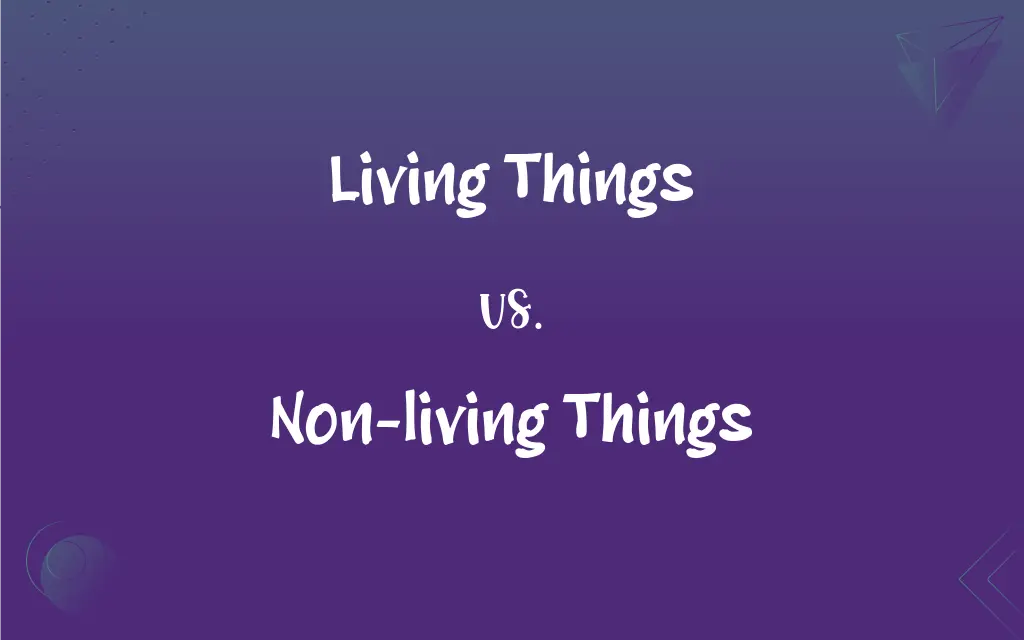Living Things vs. Non-living Things: What's the Difference?
Edited by Aimie Carlson || By Harlon Moss || Updated on October 5, 2023
Living Things exhibit growth, reproduction, and metabolism, while Non-living Things lack these biological processes and characteristics.

Key Differences
Living Things are entities that possess the characteristics of life, including the ability to grow, reproduce, and respond to stimuli. These beings have a cellular structure and undergo metabolism, which is the set of life-sustaining chemical reactions within cells. Non-living Things, conversely, don't have cells, can't reproduce or grow, and don't exhibit metabolism.
A significant distinction between Living Things and Non-living Things is their interaction with the environment. Living Things can respond to changes in their surroundings, adapting over time, and evolving as a species. Non-living Things, on the other hand, remain static and don't evolve or adapt in a biological sense.
Another critical characteristic of Living Things is their ability to reproduce. This reproduction can be sexual, requiring two individuals, or asexual, where an organism can reproduce on its own. Non-living Things lack this capacity. For instance, while a plant (a living thing) can produce seeds that grow into new plants, a rock (a non-living thing) doesn't produce other rocks.
Moreover, Living Things have a life span and eventually die, after which they decompose, returning essential nutrients to the environment. Non-living Things don't have a life span in the biological sense; they might undergo physical changes or degrade over time but don't "die" as living organisms do.
Both Living Things and Non-living Things play crucial roles in the ecosystem. While Living Things are part of the biotic components, interacting and contributing to the food chain, Non-living Things form the abiotic elements, providing essential resources and conditions for life to thrive.
ADVERTISEMENT
Comparison Chart
Cellular Structure
Possess cells
Lack cells
Metabolism
Exhibit metabolism
Don't exhibit metabolism
Reproduction
Can reproduce
Can't reproduce
Interaction with Environment
Respond to and adapt to changes
Remain static
Life Span
Have a life span and die
Don't have a biological life span
ADVERTISEMENT
Living Things and Non-living Things Definitions
Living Things
Entities that can reproduce and introduce new individuals to their species.
Birds are living things that lay eggs, leading to the birth of chicks.
Non-living Things
Items that remain static and unchanging unless acted upon by external forces.
A stone, being a non-living thing, remains unchanged unless eroded or shaped.
Living Things
Entities that have a life cycle, including birth and death.
Flowers are living things that bloom, reproduce, and eventually wither.
Non-living Things
Objects that lack the ability to grow, reproduce, or metabolize.
A chair is a non-living thing, static in its form and function.
Living Things
Living Things possess the ability to grow and develop over time.
Trees are living things that grow taller and broader as they age.
Non-living Things
Objects that don't have a biological life span or experience death.
A glass bottle, a non-living thing, doesn't age or die in a biological sense.
Living Things
Beings that can sense and react to changes in their environment.
Fish, being living things, swim away when they sense danger.
Non-living Things
Entities that don't interact biologically with their environment.
A pen, a non-living thing, doesn't respond or adapt to environmental changes.
Living Things
Organisms with cellular structures undergoing metabolism.
Humans, as living things, have trillions of cells that perform various functions.
Non-living Things
Things that don't have cellular structures or life processes.
A metal nail, being a non-living thing, doesn't possess cells or life functions.
FAQs
What defines Living Things?
Living Things grow, reproduce, metabolize, and have cellular structures.
Can Non-living Things change form over time?
Yes, Non-living Things can change physically due to external factors, but not biologically.
What's the key cellular distinction between Living Things and Non-living Things?
Living Things possess cells, while Non-living Things do not.
Do Non-living Things play a role in ecosystems?
Absolutely, Non-living Things, as abiotic factors, provide essential conditions and resources for Living Things.
How do Living Things get energy?
Living Things obtain energy from food, photosynthesis, or other organisms, depending on the species.
Can Non-living Things deteriorate over time?
Yes, Non-living Things can degrade or change due to physical or chemical processes, not biological aging.
Are all animals and plants Living Things?
Yes, all animals and plants are categorized as Living Things.
Can Non-living Things be created by Living Things?
Yes, for example, a beaver creates a dam, a Non-living Thing.
Can Living Things become Non-living Things?
When Living Things die, their remains are non-living, though they once exhibited life processes.
Can both Living Things and Non-living Things impact the environment?
Yes, both can influence their surroundings in various ways, biologically or physically.
Can Non-living Things grow or reproduce?
No, Non-living Things lack growth, reproduction, and metabolism.
Are viruses considered Living Things?
It's debated; viruses show some characteristics of Living Things when inside a host but lack others, like metabolism on their own.
Do Non-living Things have DNA?
No, DNA is a characteristic of Living Things, and Non-living Things don't possess it.
Can Living Things adapt to their environment?
Yes, Living Things can adapt and evolve in response to environmental changes.
Is there any gray area between Living Things and Non-living Things?
Entities like viruses present a gray area, exhibiting both living and non-living characteristics.
Are machines considered Living Things?
No, machines are Non-living Things, even if they exhibit movement or complex functions.
Do Living Things always need oxygen?
Not always. While many Living Things need oxygen, some can live in anaerobic conditions.
Can Non-living Things produce energy?
No, Non-living Things don't produce energy, but they can transfer or store it.
Do all Living Things require water?
While water is vital for most Living Things, some organisms can survive in extreme conditions with minimal water.
Are synthetic life forms considered Living Things?
If they exhibit the characteristics of life, such as growth and reproduction, they're considered Living Things.
About Author
Written by
Harlon MossHarlon is a seasoned quality moderator and accomplished content writer for Difference Wiki. An alumnus of the prestigious University of California, he earned his degree in Computer Science. Leveraging his academic background, Harlon brings a meticulous and informed perspective to his work, ensuring content accuracy and excellence.
Edited by
Aimie CarlsonAimie Carlson, holding a master's degree in English literature, is a fervent English language enthusiast. She lends her writing talents to Difference Wiki, a prominent website that specializes in comparisons, offering readers insightful analyses that both captivate and inform.































































